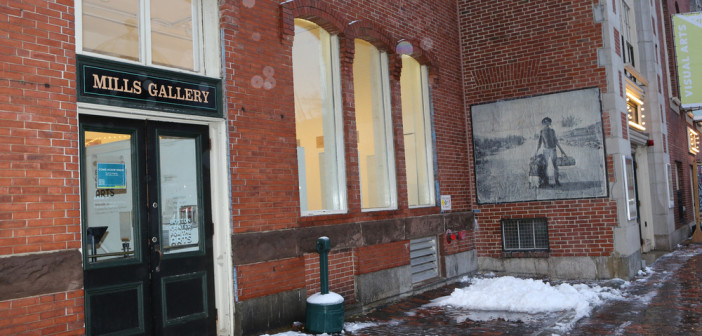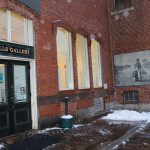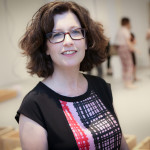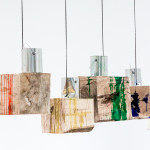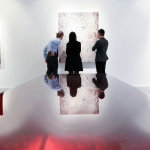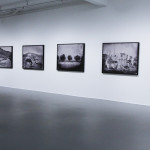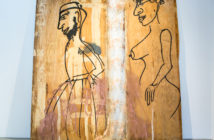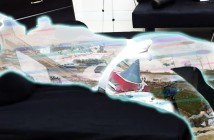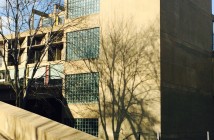"Boston Common" highlights the people and organizations that shape Boston and New England's cultural sector by going straight to the source to find out who they are, what they are doing, and how and why they do it. We hope that the interview series will champion some of the exemplary work being done, shed light on neglected issues facing our arts scene and community, build connections among individuals and organizations, and expand the networks on which we rely. In our newest installment, we talk to the Boston Center for the Arts Mills Gallery's Associate Director of Visual Arts, Randi Hopkins.
BRS Tell us a little about the Mills Gallery. What is its mission and focus, how does it differ from other organizations of its kind, and how does it operate?
Randi Hopkins The Mills Gallery at the Boston Center for the Arts is a rarity in Boston — a spacious not-for-profit exhibition space in the center of the city, not affiliated with a college or university, with a long history of showing innovative contemporary art in a high quality/low key setting. The BCA, of which the Mills Gallery is a part, is a not-for-profit performing and visual arts campus whose mission is to support working artists to create, perform and exhibit new works; develop new audiences; and connect the arts to community.
The space itself has great charm and versatility, allowing museum quality installations in a space that doesn’t conform to the traditional museum or gallery "white cube". Instead, we have big windows, lots of light, views onto and from a lively urban plaza, columns that have been painted a few too many times and some fairly funky walls if you look closely. It is a space with a history, located in a neighborhood with personality and character — I find these aspects of the Mills inspiring and energizing. The Mills is also unusual in that for the past several years, it has been operating on an "invited curator" model, which means that my role, as Associate Director of Visual Arts at the BCA, is not to curate a series of exhibitions, but rather to seek out and work with outside curators to develop projects that are well-suited to our space and mission. This gives us not only the opportunity to exhibit a broader array of art at the Mills — to reach beyond my particular interests and expertise — but also provides the opportunity to work closely with curators as well as artists in the process of organizing an exhibition, exploring the possibilities for going from idea to exhibition in a meaningful way.
BRS Why and how did you come to work at the Mills Gallery. What did you do before, and how did that work equip you for the work you do now?
RH Since I moved to Boston from New York in 1990, I’ve worked for nearly every "A" in town — the MFA, ICA, and now the BCA, not to mention spending nearly 10 years as co-founder and co-director of Allston Skirt Gallery in Allston and then SoWa, and almost 10 years writing a weekly arts column for the Boston Phoenix (OK, no "A" there…). But I started what has evolved into a multi-faceted career as arts writer, curator and gallerist in New York in the early 1980s, translating German texts for the Dia Art Foundation, under then-director Heiner Friedrich, in the office that oversaw the foundation’s European collection. This was where my real education in contemporary art began, as I translated entries for an early Blinky Palermo catalogue, and went through archival material about artists including Imi Knoebel, Georg Baselitz and Markus Lupertz.
Writing has been a through line for me, connecting my disparate activities in the arts. Though I was hired as a translator and archivist at Dia, I soon became involved in opening a new Dia exhibition space, showing John Chamberlain’s work in his former studio on Vestry Street in TriBeCa, while assisting in the compilation of a catalogue raisonne of his work. Because of Chamberlain’s friendship with Donald Judd, and Dia’s involvement with Judd’s project in Marfa, I learned a great deal about these artists. Dia was also involved with James Turrell’s Roden Crater in those years. I still feel a great attachment to the works and aesthetic that Dia championed. When that era of Dia collapsed in 1985, I left the arts for trade publishing and literary agenting, and then went back to school to become a lawyer at the end of the decade, with the idea of representing writers. Every single one of these things has contributed to what I do now.
I feel extremely fortunate to have stepped into this position at the BCA after many years of involvement with the creative community in Boston. I have such great respect for the talented curators who have made their mark here in the years I’ve been in Boston; their ambitious programs form a unique exhibition history that I look forward to building on.
That’s a longer version of my story than I usually share, but it feels important because it took me many years to understand that my interest in the arts — whether visual, literary or otherwise — has to do with supporting creativity at the point where it is still evolving and appreciating the role that organizations and visionary individuals can have in supporting innovative artists.
 Photo by Melissa Blackall Photography at Mills Gallery, Boston Center for the Arts, Jeff Huckleberry: Things about Rainbows, July 10-August 24, 2014.
Photo by Melissa Blackall Photography at Mills Gallery, Boston Center for the Arts, Jeff Huckleberry: Things about Rainbows, July 10-August 24, 2014.BRS What are your plans for the Mills Gallery in the coming year?
RH I’m interested in exploring use of the Mills Gallery as broadly as possible — as a space for interaction and connection, a social space, a space for learning and discussion. I have a long, strong interest in creating programs that are both welcoming and educational when it comes to contemporary art. I hope to see our space grow in the variety of individuals who feel connected to it, who feel like it offers them a satisfying way to participate in contemporary visual arts culture.
Over the past year (my first at the Mills Gallery), we’ve inaugurated the artists’ lounge and lively discussion salon Gertrude’s, which has been a surprise and a pleasure as each of our every-so-often meetings have generated great discussion that often veer wonderfully off course. Brave hosts so far have included Emily Eveleth and Penn Young, Lynne Cooney, Martha Buskirk and Robert Moeller, and Leonie Bradbury and Maggie Cavallo — we seem to be attracting a growing following and I’m excited to see where this goes next season.
As for exhibitions, this summer Mobius director and artist Daniel DeLuca is curating a solo exhibition of artist Jeff Huckleberry’s work. I believe that this show will function as a fantastic entry point into a rich and alternative history of performance art, in part through the fact that Jeff has invited a series of colleagues to perform and change the exhibition space over the course of the show’s 6-week run, and in part due to Daniel’s interest in Mobius’ nearly 40-year history. This show gives visibility and attention to Boston’s strong history in the realm of performance art, picks up on the current international interest in how performance art can be valuably sited in the traditional fine art exhibition context, showcases exceptional artists from the Boston area and introduces audiences to nationally significant performance artists. Also this summer, our public art resident Liz Nofziger is creating a mutant communal ping pong table for the BCA plaza. It will be available for creative public play 24/7, and we expect to have a lot of fun with that.
September 2014 brings the internationally renowned experimental filmmakers Antje Ehmanns and Harun Farocki to the Mills Gallery, thanks to the Goethe-Institut/Boston, in an exhibition that explores the idea of Labor around the world. The show will coincide with the opening of a sister show in Berlin; these shows mark the culmination of a major international project by Ehmanns and Farocki.
In the holiday spirit, December at the Mills we’re planning a Holiday Pop-Up show with new work by artists who work in our Artist Studios Building. Artist Matt Rich is curating an open-ended experiment in hands-on participation in early 2015, inviting participants to generate and/or activate a series of Action Scripts in the out-there tradition of Brian Eno and Peter Schmidt’s Oblique Strategies, and Vera Grant is curating a solo show of work by artist James Montford next spring… we have a lot of good stuff coming up.
Overall, I hope that our upcoming exhibition and residency programs reflect our commitment to fostering public engagement and participation in the visual arts in Boston, showing great art, and actively working with curators and artists to develop their vision and craft, with a belief that the kinds of responses and conversations that art can elicit should be as broad and wide as possible.
 Photo by Melissa Blackall Photography at Mills Gallery, Boston Center for the Arts, Jordan Eagles: Blood Dust, April 25 — June 29, 2-14.
Photo by Melissa Blackall Photography at Mills Gallery, Boston Center for the Arts, Jordan Eagles: Blood Dust, April 25 — June 29, 2-14.BRS What are some challenges you face in your job, and how are you working to address them? What's your biggest need right now?
RH I think the challenge for me is to think about how to make the Boston Center for the Arts feel like a real center to a wider variety of audiences and potential audiences, a welcoming place with a great deal to offer a broad spectrum of individuals for whom visual art and creative culture could play a vital role in their lives. The BCA as a whole is committed to thinking about this and related questions right now, and I think this open-ended, question-driven approach to how we can best serve our community will be beneficial for us.
Of course, financial support is always a large challenge, as well. It is remarkable how much gets done on the budget available at the BCA, but the Mills Gallery’s commitment to the visual arts has been sustained and has benefited innumerable artists and audiences over many years. I can’t stress enough to anyone who cares about keeping the creative community in Boston vital — it doesn’t take that much to make an enormous difference to an organization like the BCA. Contributions from our donors and supporters are highly valued by us, and go a LONG WAY. Plus, the rewards of becoming involved with the visual arts at that level are great — I think we’re a pretty interesting gang to hang around with!
BRS What advice do you have for someone looking to follow in your footsteps?
RH I’d encourage aspiring curators, writers, or gallerists to work hard, never stop learning, and follow their own sense of what they’re good at, to be patient with themselves in figuring out what kind of contribution they can make to their field. This really is a field in which relationships are key, so I’d also encourage people to do their best to get involved, look at exhibitions, read reviews and articles, find out who’s doing the kinds of things they might be interested in, among their friends, or the professional community around them (teachers, gallerists, artists, scholars — whatever their specific interest is). It’s important to talk to others, to let them know what you’re up to and to find out what they’re up to. Be interested. Be supportive. Of course, all of this comes second to working hard and making the best work you can (as an artist or any related field).
BRS What do you wish you knew when you first started out?
RH That one day, all of my scattered and various interests and skills would start to come together in a somewhat coherent vision and career.
 Photo by Melissa Blackall Photography at Mills Gallery, Boston Center for the Arts, BRINK v1, February 13-April 13, 2014.
Photo by Melissa Blackall Photography at Mills Gallery, Boston Center for the Arts, BRINK v1, February 13-April 13, 2014.BRS Name one challenge that the Boston cultural sector faces, and how you’d suggest fixing it.
RH Despite our great museums and love of culture in Boston, generous and enthusiastic support for the visual arts — especially contemporary art — doesn’t seem to extend too far beyond traditional patrons for traditional, large arts organizations in our city. Having said that, however, there certainly seems to be a new openness towards contemporary art in the air in Boston, with interest in art in public places growing — including a crucial openness to expanded definitions of that art form — and also a refreshing interest in ways that our smart and tech-savvy city can use these strengths to creating excitement around new art in Boston. I hope this leads to greater understanding of the community-wide benefits of having great art in our city, as well as an enthusiasm for providing more funding for it.
BRS Tell us about one cultural event/exhibition or organization/individual(other than your own) that has exceeded your expectations recently. What work are they doing, and why is it important?
RH Lots of exciting conversations and activities are taking place around the idea of public art or art in public places in Boston right now, and I think efforts of artist/ entrepreneur Jeff Grantz and his plans for a projection, music, arts and performance festival in Boston this fall is important in that he’s gathered a large and diverse group of artists around him to put together something that will engage the entire city with wonderful, dynamic art being created here. I think this can become a source of real pride for Boston as a city. Along those lines, Deborah Davidson and her Catalyst Conversation series is becoming an important source for dialogue and consideration of important ideas around art in Boston, as is Cedric Douglas and his mobile Up Truck, taking art to the streets and the community, which I learned about at the Greater Boston Cultural Convening at the Strand Theater in May. That two-day convening, on the large topic "Making Greater Boston Greater, An Arts & Culture 21st Century New Urban Agenda," brought up a host of subjects that I think are key to our artistic future here & now.
- Photo by Melissa Blackall Photography at Mills Gallery, Boston Center for the Arts, BRINK v1, February 13-April 13, 2014
- Photo by Melissa Blackall Photography
- Photo by Melissa Blackall Photography at Mills Gallery, Boston Center for the Arts, Jeff Huckleberry: Things about Rainbows, July 10-August 24, 2014.
- Photo by Melissa Blackall Photography at Mills Gallery, Boston Center for the Arts, Jordan Eagles: Blood Dust, April 25 — June 29, 2-14.
- Photo by Melissa Blackall Photography at Mills Gallery, Boston Center for the Arts, BRINK v1, February 13-April 13, 2014.
The Mills Gallery at the Boston Center for the Arts is located at 539 Tremont Street, Boston, MA.

